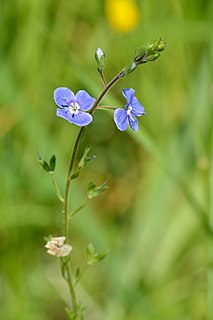Related Research Articles
This article gives an overview of the plant communities formed by vegetation of open habitats in the British National Vegetation Classification system.
British NVC community OV5 is an open habitat community in the British National Vegetation Classification system. It is one of six arable weed and track-side communities of light, less-fertile acid soils.

Veronica is the largest genus in the flowering plant family Plantaginaceae, with about 500 species; it was formerly classified in the family Scrophulariaceae. Common names include speedwell, bird's eye, and gypsyweed.

Veronica persica is a flowering plant in the family Plantaginaceae. It is native to Eurasia and is widespread as an introduced species in the British Isles, North America, eastern Asia, including Japan and China, and Australia and New Zealand.

Veronica polita, or grey field-speedwell, is a herbaceous flowering plant species in the plantain family Plantaginaceae. It has hairy stems, is either prostrate or ascending, with dull green leaves that are one of petiolate, serrate, ovate (rounded) and usually wider than long.The flowers are small and bright blue. The plant has solitary axillary peduncles that are shorter or slightly longer than the leaves. It is native to Eurasia, possibly including the British Isles, western Asia, northern Africa, and North America, but has been introduced into suitable habitats worldwide as a weed of cultivation. It is susceptible to downy mildew disease caused by the oomycete species Peronospora agrestis.
British NVC community OV9 is one of the open habitat communities in the British National Vegetation Classification system. It is one of eight arable weed and wasteland communities of fertile loams and clays.
British NVC community OV1 is one of the open habitat communities in the British National Vegetation Classification system. It is one of six arable weed and track-side communities of light, less-fertile acid soils.
British NVC community OV2 is one of the open habitat communities in the British National Vegetation Classification system. It is one of six arable weed and track-side communities of light, less-fertile acid soils.
British NVC community OV3 is one of the open habitat communities in the British National Vegetation Classification system. It is one of six arable weed and track-side communities of light, less-fertile acid soils.
British NVC community OV6 is one of the open habitat communities in the British National Vegetation Classification system. It is one of six arable weed and track-side communities of light, less-fertile acid soils.
British NVC community OV8 is one of the open habitat communities in the British National Vegetation Classification system. It is one of eight arable weed and wasteland communities of fertile loams and clays.
British NVC community OV10 is one of the open habitat communities in the British National Vegetation Classification system. It is one of eight arable weed and wasteland communities of fertile loams and clays.
British NVC community OV11 is one of the open habitat communities in the British National Vegetation Classification system. It is one of eight arable weed and wasteland communities of fertile loams and clays.
British NVC community OV12 is one of the open habitat communities in the British National Vegetation Classification system. It is one of eight arable weed and wasteland communities of fertile loams and clays.
British NVC community OV13 is one of the open habitat communities in the British National Vegetation Classification system. It is one of eight arable weed and wasteland communities of fertile loams and clays.
British NVC community OV14 is one of the open habitat communities in the British National Vegetation Classification system. It is one of eight arable weed and wasteland communities of fertile loams and clays.

Veronica filiformis is a species of flowering plant in the family Plantaginaceae. It is known by many common names, including slender speedwell, creeping speedwell, threadstalk speedwell and Whetzel weed. It is native to eastern Europe and western Asia, and it is known in many other regions as an introduced species.
British NVC community OV15 is one of the open habitat communities in the British National Vegetation Classification system. It is one of two arable weed communities of light lime-rich soils.
British NVC community OV16 is one of the open habitat communities in the British National Vegetation Classification system. It is one of two arable weed communities of light lime-rich soils.
British NVC community OV17 is one of the open habitat communities in the British National Vegetation Classification system. Although classed with communities OV15 and OV16 as an arable weed community of light lime-rich soils, it also shares many features with the communities classed as arable weed and wasteland communities of fertile loams and clays.
References
Rodwell, John S, ed. (March 2000). Maritime communities and vegetation of open habitats. British Plant Communities. Vol. 5. Cambridge University Press. ISBN 978-0-521-39167-2.
Kruseman, G; Vlieger, J (1939). "Akkerassociaties in Nederland". Nederlandsch Kruidkundig Archief. Utrecht: Nederlandsche Botanische Vereeniging. 49: 327–98.